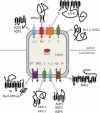Saccharomyces cerivisiae as a model system for kidney disease: what can yeast tell us about renal function?
- PMID: 21490136
- PMCID: PMC3129885
- DOI: 10.1152/ajprenal.00141.2011
Saccharomyces cerivisiae as a model system for kidney disease: what can yeast tell us about renal function?
Abstract
Ion channels, solute transporters, aquaporins, and factors required for signal transduction are vital for kidney function. Because mutations in these proteins or in associated regulatory factors can lead to disease, an investigation into their biogenesis, activities, and interplay with other proteins is essential. To this end, the yeast, Saccharomyces cerevisiae, represents a powerful experimental system. Proteins expressed in yeast include the following: 1) ion channels, including the epithelial sodium channel, members of the inward rectifying potassium channel family, and cystic fibrosis transmembrane conductance regulator; 2) plasma membrane transporters, such as the Na(+)-K(+)-ATPase, the Na(+)-phosphate cotransporter, and the Na(+)-H(+) ATPase; 3) aquaporins 1-4; and 4) proteins such as serum/glucocorticoid-induced kinase 1, phosphoinositide-dependent kinase 1, Rh glycoprotein kidney, and trehalase. The variety of proteins expressed and studied emphasizes the versatility of yeast, and, because of the many available tools in this organism, results can be obtained rapidly and economically. In most cases, data gathered using yeast have been substantiated in higher cell types. These attributes validate yeast as a model system to explore renal physiology and suggest that research initiated using this system may lead to novel therapeutics.
Figures

Similar articles
-
Membrane permeability. The diversity of transmembrane transport processes.Curr Opin Cell Biol. 1997 Aug;9(4):543-6. doi: 10.1016/s0955-0674(97)80031-2. Curr Opin Cell Biol. 1997. PMID: 9261063 No abstract available.
-
Role of the energy sensor AMP-activated protein kinase in renal physiology and disease.Am J Physiol Renal Physiol. 2010 May;298(5):F1067-77. doi: 10.1152/ajprenal.00005.2010. Epub 2010 Feb 24. Am J Physiol Renal Physiol. 2010. PMID: 20181668 Free PMC article. Review.
-
Saccharomyces cerevisiae: First Steps to a Suitable Model System To Study the Function and Intracellular Transport of Human Kidney Anion Exchanger 1.mSphere. 2020 Jan 29;5(1):e00802-19. doi: 10.1128/mSphere.00802-19. mSphere. 2020. PMID: 31996424 Free PMC article.
-
Functional significance of channels and transporters expressed in the inner ear and kidney.Am J Physiol Cell Physiol. 2007 Oct;293(4):C1187-208. doi: 10.1152/ajpcell.00024.2007. Epub 2007 Aug 1. Am J Physiol Cell Physiol. 2007. PMID: 17670895 Review.
-
Use of Saccharomyces cerevisiae for patch-clamp analysis of heterologous membrane proteins: characterization of Kat1, an inward-rectifying K+ channel from Arabidopsis thaliana, and comparison with endogeneous yeast channels and carriers.Proc Natl Acad Sci U S A. 1995 Mar 28;92(7):2701-5. doi: 10.1073/pnas.92.7.2701. Proc Natl Acad Sci U S A. 1995. PMID: 7708709 Free PMC article.
Cited by
-
Endoplasmic reticulum-associated degradation of the renal potassium channel, ROMK, leads to type II Bartter syndrome.J Biol Chem. 2017 Aug 4;292(31):12813-12827. doi: 10.1074/jbc.M117.786376. Epub 2017 Jun 19. J Biol Chem. 2017. PMID: 28630040 Free PMC article.
-
Drosophila melanogaster: a simple genetic model of kidney structure, function and disease.Nat Rev Nephrol. 2022 Jul;18(7):417-434. doi: 10.1038/s41581-022-00561-4. Epub 2022 Apr 11. Nat Rev Nephrol. 2022. PMID: 35411063 Review.
-
Serum and Glucocorticoid Regulated Kinase 1 in Sodium Homeostasis.Int J Mol Sci. 2016 Aug 10;17(8):1307. doi: 10.3390/ijms17081307. Int J Mol Sci. 2016. PMID: 27517916 Free PMC article. Review.
-
SLC26A9 is selected for endoplasmic reticulum associated degradation (ERAD) via Hsp70-dependent targeting of the soluble STAS domain.Biochem J. 2021 Dec 22;478(24):4203-4220. doi: 10.1042/BCJ20210644. Biochem J. 2021. PMID: 34821356 Free PMC article.
-
Early-onset torsion dystonia: a novel high-throughput yeast genetic screen for factors modifying protein levels of torsinAΔE.Dis Model Mech. 2017 Sep 1;10(9):1129-1140. doi: 10.1242/dmm.029926. Epub 2017 Aug 2. Dis Model Mech. 2017. PMID: 28768697 Free PMC article.
References
-
- Bayascas JR. Dissecting the role of the 3-phosphoinositide-dependent protein kinase-1 (PDK1) signalling pathways. Cell Cycle 7:2978–2982, 2008 - PubMed
-
- Beguin P, Hasler U, Staub O, Geering K. Endoplasmic reticulum quality control of oligomeric membrane proteins: topogenic determinants involved in the degradation of the unassembled Na,K-ATPase alpha subunit and in its stabilization by beta subunit assembly. Mol Biol Cell 11:1657–1672, 2000 - PMC - PubMed
Publication types
MeSH terms
Substances
Grants and funding
LinkOut - more resources
Full Text Sources
Medical
Molecular Biology Databases

